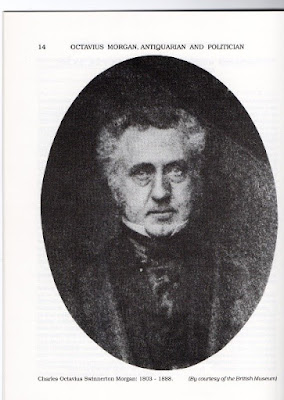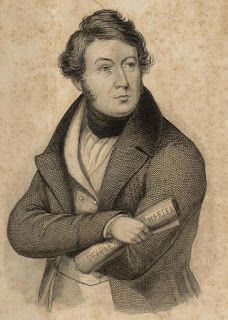Octavius Morgan, an Antiquarian with a passion for Collection and Curation.
By Mary Evans
In early February before lockdown would radically affect our way of life I joined a group of National Trust volunteers from Tredegar House on a visit to the British Museum. The morning was given over to a guided tour of the Horological Collection with one of its curators Oliver Cooke. We were accorded this privilege because of the connection between Tredegar House and one of the Collection’s most significant benefactors, Charles Octavius Swinnerton Morgan.
Charles Octavius Swinnerton Morgan (1803-1888)
 |
| David H Williams, ‘Octavius Morgan, Antiquarian and Politician’. The Monmouthshire Antiquary, Vol XIII (1997) pp. 13-17. |
Known as Octavius Morgan he was the fourth son of Sir Charles Morgan 2nd Baronet (1760-1846) and Mary (née Stoney). This rare picture of him is featured in a profile by David H.Williams. Until 1839 he lived at Tredegar House, for over 500 years the home of the powerful Morgan family later Lords Tredegar. Octavius’s eldest brother Charles Morgan Robinson Morgan became the first Lord Tredegar, in 1859. Monmouthshire Antiquarian Association members will know Octavius was a renowned antiquarian, keen archaeologist and local historian. A founder member of the Caerleon Antiquarian Society, which later added Monmouthshire to its name, he was President of the Association for 35 years. Members might not be aware of the following unflattering description of him in a document in the Tredegar archives.
Mr Octavius Morgan as a young man was vain, flippant and conceited. Like the Morgans he was pygmy in stature, of a pale, languid complexion and rather effeminate. Although he could converse volubly on most subjects, his voice was squeaky. He delivered his opinions in a dogmatic, overbearing and arrogant manner. He was a great favourite with his father, and during the life of the old baronet, he completely ‘ruled the roost’ at Tredegar. 1
This contemporary account was published anonymously as Memories of Monmouthshire, but later attributed to a fellow MP, Reginald Blewitt, who owned the Monmouthshire Merlin and lived in Llantarnam Abbey. In 1840 the sentence of the three Monmouthshire Chartist leaders to be hanged, drawn and quartered, was reduced to transportation to Tasmania for life and both Octavius Morgan and Reginald Blewitt opposed the commutation.
Riches and Rebellion
The Riches and Rebellion exhibition, which opened last autumn in Tredegar House to mark the 180th anniversary of the Chartist March on Newport in 1839, explored the role of the Morgans of Tredegar in the Newport Rising. It displayed items on loan from Newport Museum which were collected by Octavius Morgan. We can only speculate how or why Octavius obtained these items. A significant item on display was one of the pistols found on John Frost at the time of his arrest the day after the Rising. Emily Price, House and Collections Manager at Tredegar House, states that it is believed the pistol had been taken from John Frost by Thomas Philips (the mayor of Newport). It is thought that it came into Octavius' possession as he gave it to Caerleon Museum and eventually some items were given to Newport Museum.
 |
| One of three pistols seized from John Frost when
arrested at John Partridge's house on night of the Newport
Rising. Photograph and artefact, copyright Newport Museum & Art Gallery |
The Exhibition of Treasures of Tredegar House in 2016
Tredegar House webpage has 2,371 items listed on its online National Trust Collections. In the autumn of 2016 I was part of a small team of volunteers which presented an exhibition to visitors on Treasures of Tredegar which had been researched and organised by the National Trust staff at Tredegar House. The research team acknowledged that the Tredegar Collection of the 20th century was indebted to Octavius Morgan's collecting practices and that ‘almost every item in the archive, now in the National Library of Wales has been labelled by Octavius.3 The main highlights were displayed in the Master’s Bedchamber which would have been bedroom, dining room and office. It is here that you can currently see the two paintings from around 1620 which Octavius Morgan credited with inspiring his love of horology.
He wrote the following comment in an article entitled 'Observations on the classification and arrangement of a collection of watches' in the Archaeological Journal of 1875 page 189: |
Reproduced with permission of Newport Museum
& Art Gallery attributed by Octavius Morgan to
'Jansen' see link to Archaeological Journal above.
|
In the year 1837, I purchased at Ratisbon, from a watch-maker who had a few ancient watches, one of which was the counterpart of a watch which I had always been accustomed to see in a portrait of one of my ancestors, who carried it in her hand, the picture being dated 1620. In another portrait of the same date (both by Jansen), the same lady wore at her side another watch of a different form. Thus was my attention turned to ancient watches and I began to study their history and peculiarities and to form a collection. 4
It is widely accepted that the paintings referenced are those that hang in the Master’s Bedchamber. Shown here is A Girl of the Morgan Family, thought to be around 17 years old and holding a watch in her right hand. Both are part of the collection on loan to the National Trust from Newport Museum and Art Gallery.
It was this exhibition of Treasures that sparked my interest in Octavius and his horology collection. I needed no encouragement to sign up last year to the planned trip to the British Museum.
The Horology Collection at The British Museum
Clocks and watches in the Collection are housed on the first floor at the front of the building in The Sir Harry and Lady Djanogly Gallery opened in 2008. On display in the Collection the most spectacular piece for our volunteers was the mechanical galleon.
The Mechanical Galleon
The Mechanical Galleon was chosen as number 76 in the 'History of the World in 100 Objects' series of radio programmes created in partnership between the BBC and British Museum and presented in 2010 by Neil MacGregor, former Director of the British Museum. A fascinating commentary is available to download in text and audio.
In the programme Neil MacGregor informs us:
David Thompson the former curator of the Horology Collection comments on the same website:
 |
Picture taken by the author, 4 February 2020, at the British Museum
|
The Mechanical Galleon was chosen as number 76 in the 'History of the World in 100 Objects' series of radio programmes created in partnership between the BBC and British Museum and presented in 2010 by Neil MacGregor, former Director of the British Museum. A fascinating commentary is available to download in text and audio.
In the programme Neil MacGregor informs us:
... it is an elaborate, automated clock. Its mechanism no longer works but originally it would have played music, fired its cannons and trundled across the table at imperial banquets. Clocks like this were important status symbols in the courts of Europe in the 1500s and this clock is based on the great European ships that sailed the oceans during this period.
David Thompson the former curator of the Horology Collection comments on the same website:
Such a spectacular piece would have been the envy of all those illustrious guests invited to a grand banquet hosted by an Elector. It was a wildly expensive entertainment, a rich and lavish display of wealth, and a magical experience for all those who witnessed its performance. As it was in the 1580s, this is a wonderful machine which still fascinates us today.
 |
Reproduced under the creative commons
licence of the British Museum
|
Unfortunately the Museum was not willing to part with one hundred pounds for the clock. Morgan bought it for himself and took it back to his house, The Friars, in Newport, South Wales. It stood at the bottom of the main staircase until his death in 1888, when it was bequeathed to The British Museum along with the rest of his amazing collection of clocks and watches. 5
 |
| Picture taken by the author 20 June 2020 |
 |
| 'Seat of Octavious Morgan', attributed to Flewitt Mullock Mr Langton (architect): J. Holloway (lithographer) copyright Newport Museum and Art Gallery |
 |
| Picture taken by author 20 June 2020 |
In 1913 Courtney Morgan, Lord Tredegar, gave the Friars to the Royal Gwent Hospital in memory of his uncle Godfrey Charles Morgan, Viscount Tredegar who had been president of the hospital for 37 years. Godfrey survived the Charge of the Light Brigade and was the nephew of Octavius. The building served as a convalescent home from 1914 to 1935 when it became the Nurses Preliminary Training School. During the 1980s I visited it on several occasions as my mother was the Supplies Officer for the South East Wales Area Health Authority which was based in the Friars. Today it is the Postgraduate Centre for the Aneurin Bevan University Health Board.
The Will of Octavius Morgan
Octavius Morgan inherited an ample fortune and never married. In 1888 he died at the Friars and was buried in the family vault at St Basil’s Churchyard, Bassaleg. By the time he wrote his will in 1876 he was able to bequeath over 300 objects to the British Museum. The National Collection was enriched by this bequest and to the ‘family mansion at Tredegar’ he bequeathed his silver collection and ‘collection of printed books, book of plate and prints’.3
In the archive at Tredegar House is the obituary written by John Evans (President of the Society of Antiquaries) who presented a contrasting picture to that attributed to Reginald Blewitt.
Personally Mr Octavius Morgan was a delightful companion, full of information on his favourite subjects, and willing to impart it, and all our fellows of the older generation will cherish his memory with respect. 1
Mary Evans
Sources:
Click on words in red to access other websites.
Click on words in red to access other websites.
1. ‘Tic Toc’, June 2019, Archived Monthly Newsletter of Tredegar House produced by the Archive Team of Tredegar House for volunteers.
2. Monmouthshire Antiquarian Association 'Catalogue of Correspondence.'
3.'Treasures of Tredegar Exhibition Engagement Handbook'. The National Trust, Tredegar House. September 2016.
4. Octavius Morgan, 'Observations on the classification and arrangement of a collection of watches' Archaeological Journal Vol. 32, 1875, Issue 1. Pages 188-204.
2. Monmouthshire Antiquarian Association 'Catalogue of Correspondence.'
3.'Treasures of Tredegar Exhibition Engagement Handbook'. The National Trust, Tredegar House. September 2016.
4. Octavius Morgan, 'Observations on the classification and arrangement of a collection of watches' Archaeological Journal Vol. 32, 1875, Issue 1. Pages 188-204.
5. David Thompson 'Clocks', London, 2004, pp. 48-51.
My thanks to:
Lionel Clauzon of Newport Reference Library who scanned to me a copy of the 15 pages of Octavius’s Will held by Newport Reference Library.
and Emily Price, House and Collections Manager, Tredegar House for her help and advice on the Archives at Tredegar House. Lionel Clauzon of Newport Reference Library who scanned to me a copy of the 15 pages of Octavius’s Will held by Newport Reference Library.


Comments
Post a Comment